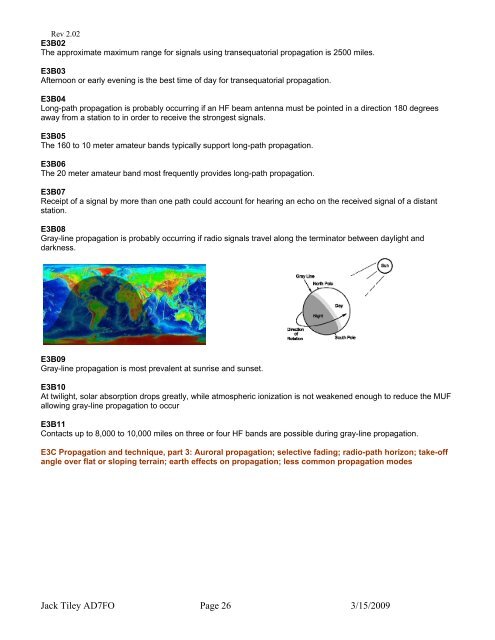You also want an ePaper? Increase the reach of your titles
YUMPU automatically turns print PDFs into web optimized ePapers that Google loves.
Rev 2.02<br />
E3B02<br />
The approximate maximum range for signals using transequatorial propagation is 2500 miles.<br />
E3B03<br />
Afternoon or early evening is the best time of day for transequatorial propagation.<br />
E3B04<br />
Long-path propagation is probably occurring if an HF beam antenna must be pointed in a direction 180 degrees<br />
away from a station to in order to receive the strongest signals.<br />
E3B05<br />
The 160 to 10 meter amateur bands typically support long-path propagation.<br />
E3B06<br />
The 20 meter amateur band most frequently provides long-path propagation.<br />
E3B07<br />
Receipt of a signal by more than one path could account for hearing an echo on the received signal of a distant<br />
station.<br />
E3B08<br />
Gray-line propagation is probably occurring if radio signals travel along the terminator between daylight and<br />
darkness.<br />
E3B09<br />
Gray-line propagation is most prevalent at sunrise and sunset.<br />
E3B10<br />
At twilight, solar absorption drops greatly, while atmospheric ionization is not weakened enough to reduce the MUF<br />
allowing gray-line propagation to occur<br />
E3B11<br />
Contacts up to 8,000 to 10,000 miles on three or four HF bands are possible during gray-line propagation.<br />
E3C Propagation and technique, part 3: Auroral propagation; selective fading; radio-path horizon; take-off<br />
angle over flat or sloping terrain; earth effects on propagation; less common propagation modes<br />
Jack Tiley <strong>AD7FO</strong> Page 26 3/15/2009


